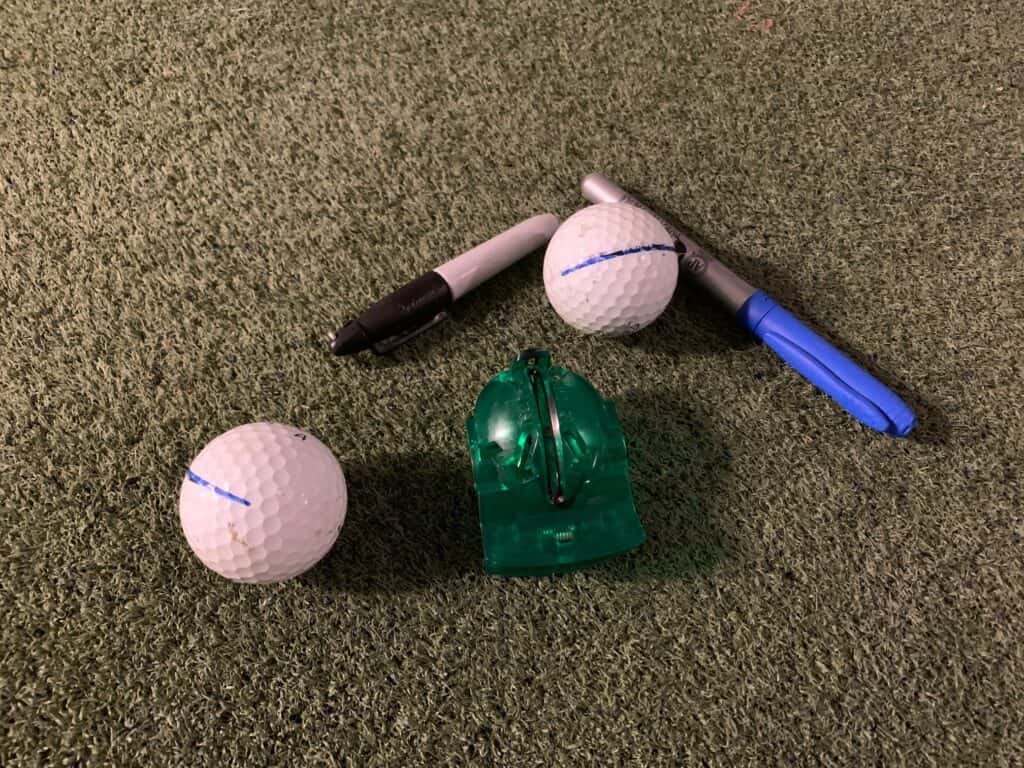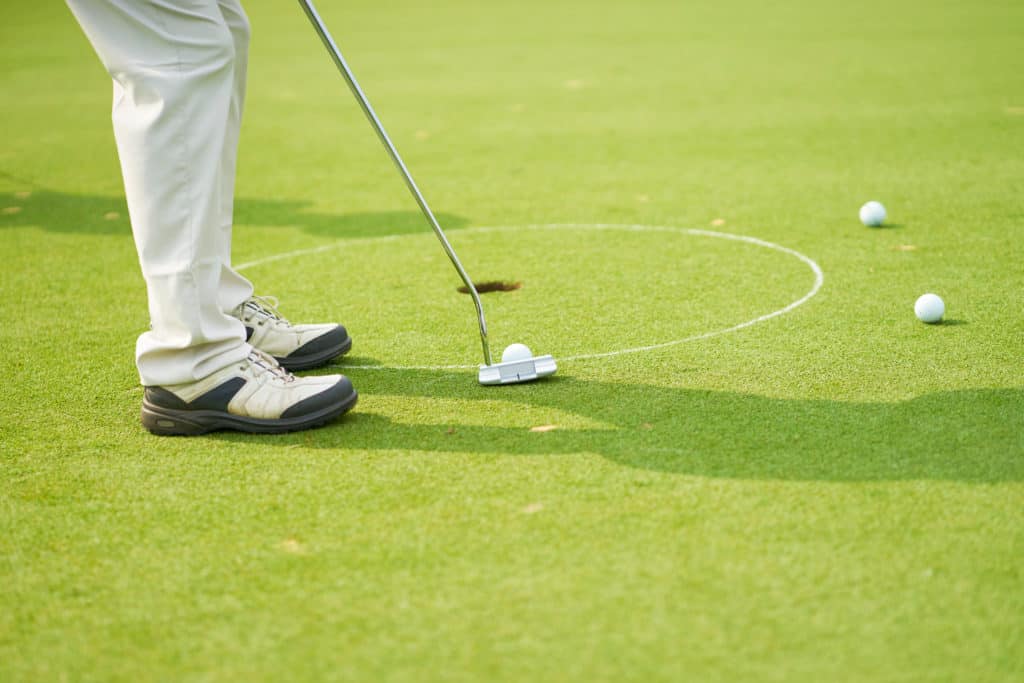Any putt in golf where the golfer is simply trying to get the ball as close to the hole to ensure the next putt is simple and makeable. Typically, the lag putt occurs from putts 30 feet or more from the hole or a putt with a severe slope in the green. The golfer is typically thrilled to keep the putt within 2 feet of the hole for a simple tap in on the next putt.
Three putt avoidance in the game of golf is very important!
There is nothing worse than hitting a green in regulation, only to three putt and make a bogey. Oftentimes, the golfers that can avoid three putts during a round of golf and over the course of a 4 round tournament, will find themselves in position to be at the top of the leaderboard.
Not only is the three putt devastating to the scoreboard, but it also hurts your confidence and morale while on the golf course. Getting good at lag putting can be something most golfers can accomplish with the right amount of practice.
Let’s start off with the basics!
What Is A Lag Putt?
Update: It’s all about feel and practice these 30 foot plus putts frequently. I best learn to hit lag putts when I played the most difficult greens I have ever played in my life on a consistent basis. The undulation on these greens were unbelievable, but took great feel, concentration and planning. It made lag putts at other courses seem simple!
The wise golfer will know when to be aggressive with putts and when to lag the putt. Too often, amateurs are too aggressive on putts from 30 feet and beyond. Once a golfer reaches this point, the make percentage on the PGA Tour is only 7%. The chances of amateur making this putt might be even lower.
The 2 putt percentage from 30 feet on the PGA Tour is 88%. The amateur golfer needs to focus on lagging the ball to 2-3 feet to ensure they are able to have a stress free, simple tap in that allows them to move onto the next hole with a positive mindset and the confidence in place.
Resource: How To Make More Short Putts (5 Simple Steps)
Overall, the golfer can build up their ability to hit successful lag putts. It is a skill that any golfer, regardless of swing speed, strength or flexibility can accomplish. That is one great thing about the short game! It can be improved by just about every golfer with the right amount of practice. It doesn’t take perfect technique, great speed or overall strength to be a wonderful and better than most short game expert.
The time spent on the short game can be a separator for most if you are looking for an edge over your playing partners or competition!
Resource: Is A New Putter Worth It?

Lag Putting Drills
There are 5 drills that we have used to improve our own game and to help our students take their lag putting to the next level. The goal we set is to get the ball inside of 3 feet 90% of the time.
Drill #1 – 30,40,50 Drill
- On the practice green, set up a tee at 30, 40 and 50 feet.
- Hit a put from 30 feet, then 40 feet and 50 feet.
- The goal is to hit all three putts inside of 3 feet.
- Assess how many times out of 10, you can get all 3 putts inside of the 3 foot circle around the hole.
- Repeat every time you practice and monitor for growth.
Drill #2 – Block Practice
- Hit 10 putts from 30 feet, then 10 putts from 40 feet and then 10 putts from 50 feet.
- Track your percentage of success at each distance.
- Ass how many putts out of 10 you were able to get inside of 3 feet.
- Repeat every time you practice and monitor for growth.
Drill #3 – Pre Round Practice
- The goal here is to build up your feel for the speed of the greens.
- Hit 3 putts from the 30, 40 and 50 foot range. Repeat as needed until you have a speed feel for the greens
- Also, don’t forget to practice your 3 to 10 footers to build confidence on those shorter putts.
Drill #4 – Build A Reference Point
For the more mechanical golfer that prefers to have a baseline for how long a putt will roll, we have an excellent measuring process to help you as you prepare for a round and build a baseline of how far a putt will roll. Check out this routine below!
- Find a relatively flat spot on the practicing putting green.
- With your normal width stance, hit a putt with a putting stroke that goes to your back foot and through. Try to repeat this swing 3-5 times being consistent with the length of your putting stroke and the pace of your putting stroke.
- Measure, by walking off the distance, how far the putts rolled.
- For example, if the putts rolled 15 feet, you now have a baseline that a putting stroke where you take it to your back foot and through will roll 15 feet on average on a flat putt.
- Over the course of the round, you can use your back foot as the baseline for how long a putt will travel.
- For each putt during your round, pace off how long the putt is and adjust accordingly based on the back foot.
- For example, a 20 foot putt on a flat surface will require a slightly longer stroke than to your back foot. A 10 foot putt will be inside of your back foot.
Drill #5 – Game Like Situation Drill
The goal of this drill is to build some pressure and to see if you can handle it and beat the 88% two putt percentage of the PGA Tour pros at least on your local practice putting green.
- Take only one ball and throw it to a random spot on the putting green at least 30 feet or more from a hole.
- Go ahead and read the green, line up your putt and hit the putt.
- Next, if you didn’t make the putt, go ahead and hit the 2nd putt.
- Repeat this for 10 times, mixing up the length and the hole that you are using.
- Track how many times out of 10 you are able to 2 putt or less from 30 feet or more.
- Over the course of a season, monitor your progress.
This drill is wonderful as you will grind over those 3 footers and really get good at hitting the initial lag putt and then hitting those 2-4 footers under pressure! Can you beat the 88%?
Resource: How To Putt With A Mallet Putter?

Lag Putting Tips
The best lag putters don’t necessarily have great mechanics or anything special other than excellent feel and the ability to read the greens. Here are some tips to help you become a better lag putter.
- Tip 1: Use the drills above frequently!
- Tip 2: Be patient with your putting stroke. Make sure you take the putter back enough as to not have to rush or force the through putting stroke. Stay patient with soft hands as you hit those 30 plus foot putts on the course and during your practice routines.
- Tip 3: As you approach your putt from off the green, check out the overall flow of the green. Where is the high point and where is the low point? See where water would run to and keep this in mind. Make sure you check beyond the hole to see if the ball is going to run past the hole and away from you.
- Tip 4: After you have walked the green, line up the line on your ball on your initial target line. This helps you stay focused on your start line.
- Tip 5: Engrain the speed you want to hit the ball into your system. Take 3 to 4 practice strokes focusing on the feeling that you want to hit the ball. Commit to your line and the speed you have determined! Use the measuring drill above if you are more mechanical and want a reference point.
- Tip 6: If you are practicing for a tournament or plan on playing a course again, take notes on what the green did in a notebook. Use this notebook everytime you play the course and draw arrows in your notebook in the direction that the putts broke on the green. Keep this is a reference point and improve it the more frequently you play a course!
Resource: Why Do Golfers Take Their Glove Off to Putt?

The Ranges of The Most Important Distances in Putting
We believe in spending time on hitting putts in two different ranges. These two ranged include:
- 3-10 Foot Putts
- 30-50 Foot Putts
The best golfers are able to make the 3-10 footers at a higher percentage and are able to lag to within 2 feet a higher percentage of time from 30-50 feet. Getting great at these distance ranges will help take some of the pressure off your iron game and your chipping game.
If you don’t have confidence in your 5-6 footers, the chip shot will become full of tension as your start to force yourself to hit inside of 2-3 feet. Instead, have confidence in your putts in the 3-10 foot range and relax on both the chip shots and those longer lag putts.
Spending your time on the practice green in these ranges will help you become the putter you need to be to reach your goals! Golf is a fun game when the short game is clicking and you can lag the ball from a distance or make a 3-10 footer to save par after missing a green.
You will hit some shots inside the 10 foot circle on approach shots and be able to capitalize by making the birdie putt.
Golf is a game of percentages and getting good at certain distances and putts on the greens will help you take your game to the next level!
Resource: How To Putt Better (5 Simple Tips and Drills)

Final Thoughts: What Is A Lag Putt
The lag putt is often overlooked as a part of practice, until someone 3 putts several times during a round. Make it part of your practice routine and build your skill in this area. There is nothing more irritating than the 3 putt after a quality drive and an approach shot where you hit the green.
Become the putter in your group that everyone envies and talks about because of your ability to lag the putts and make those 3-10 footers. It doesn’t take great power, strength or speed, but rather some feel that is developed through drills!
Resource: 22 Fun Golf Practice Games
There are two factors that will influence putting the most:
- Speed
- Start Line
Get your speed right and get your start line right and you will make your fair share of putts! There are some putts that even when you hit your speed and your start line that you might not make. Live with the results of this and look forward to the next putt you get to try to make! Keep your mind right and focus on executing in your ability to hit the right speed and start the ball where you want.
Over the course of time, with the right experience, you will become better at reading greens through experience and practice!
Take Action – What You Can Do Today to Get Better
What does this mean for you? I believe in the following recipe to get better:
1 – Improve your motion in the golf swing by identifying a golf instructor. Here are some options:
Here is a list of golf instructors that we have reviewed:
2 – Train to swing faster and improve your swing speed. Here are some options:
Looking to gain more Speed and Distance in your swing. Two Options:
3 – Understand course strategy and work to break through your next barrier. Here is a series on breaking through:
We have provided guides on how to break 100, 90, 80 and 70. Check out more below, if interested.
4 – Practice Frequently
Did you know that I build a golf simulator in my garage and have played over 500 rounds of golf on my SkyTrak system? It has been a game changer and one worth checking out. Here are some of my other posts on golf simulators frequently asked questions:
- Is a Golf Simulator Worth It?
- How to Build a Golf Simulator?
- What is the Best Golf Simulator?
- Golf Simulator Accessories?
- How to Build a Golf Simulator for under $7000
- Top 11 Reasons to Buy a SkyTrak
- How to Build a Golf Simulator for Under $1000
- Why Build A Golf Simulator?
- What Space is Needed?
- Can A Golf Simulator Improve My Game?
- How Much Does A Golf Simulator Cost?
- Don’t Forget to Check out our 15 best golf swings of all time.
I am an amateur golfer on a journey to get better, enjoy the game as often as possible and share my passion and knowledge with others. I have coached high school golfers at a high level and have a great passion for the game and want to give back. I enjoy learning about the golf swing and am currently studying to be a certified professional golf instructor. Join me in our journey to get better everyday.

